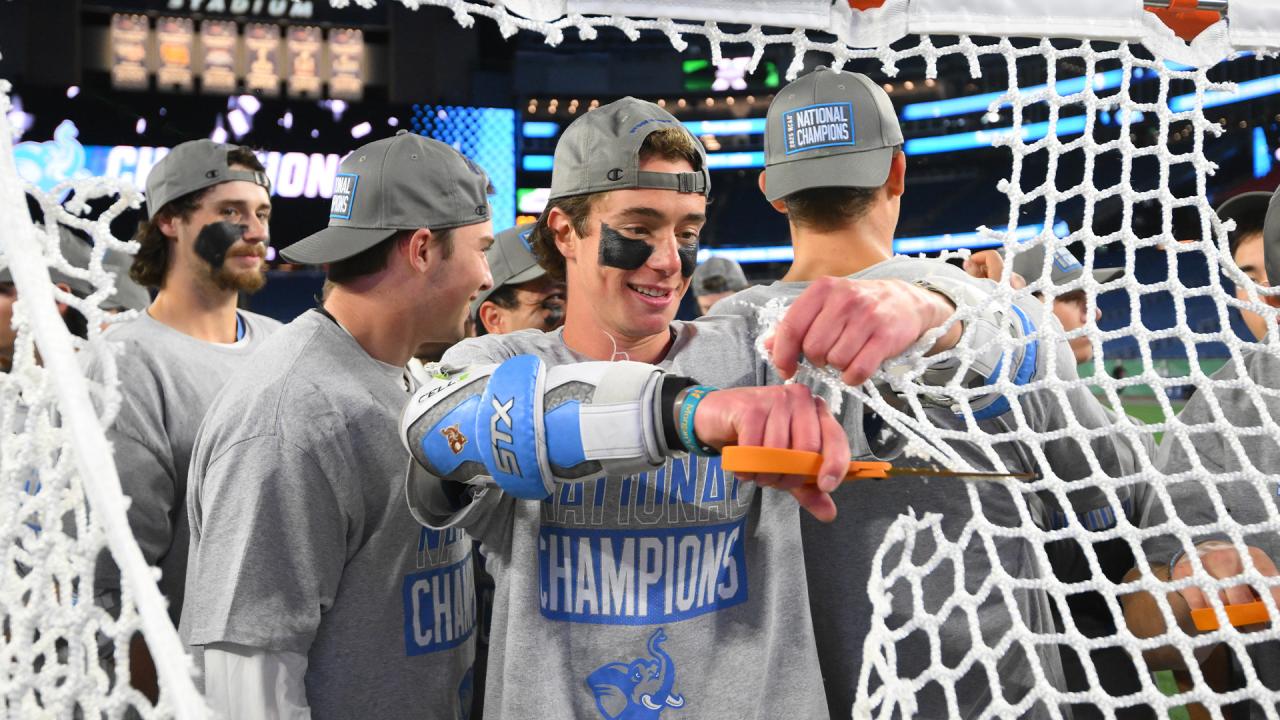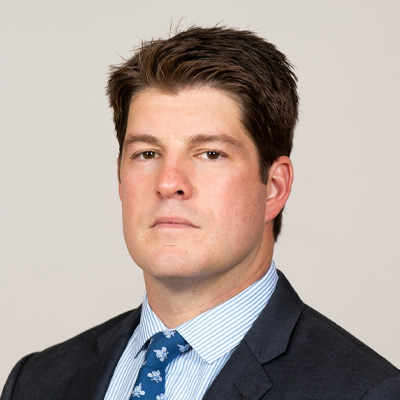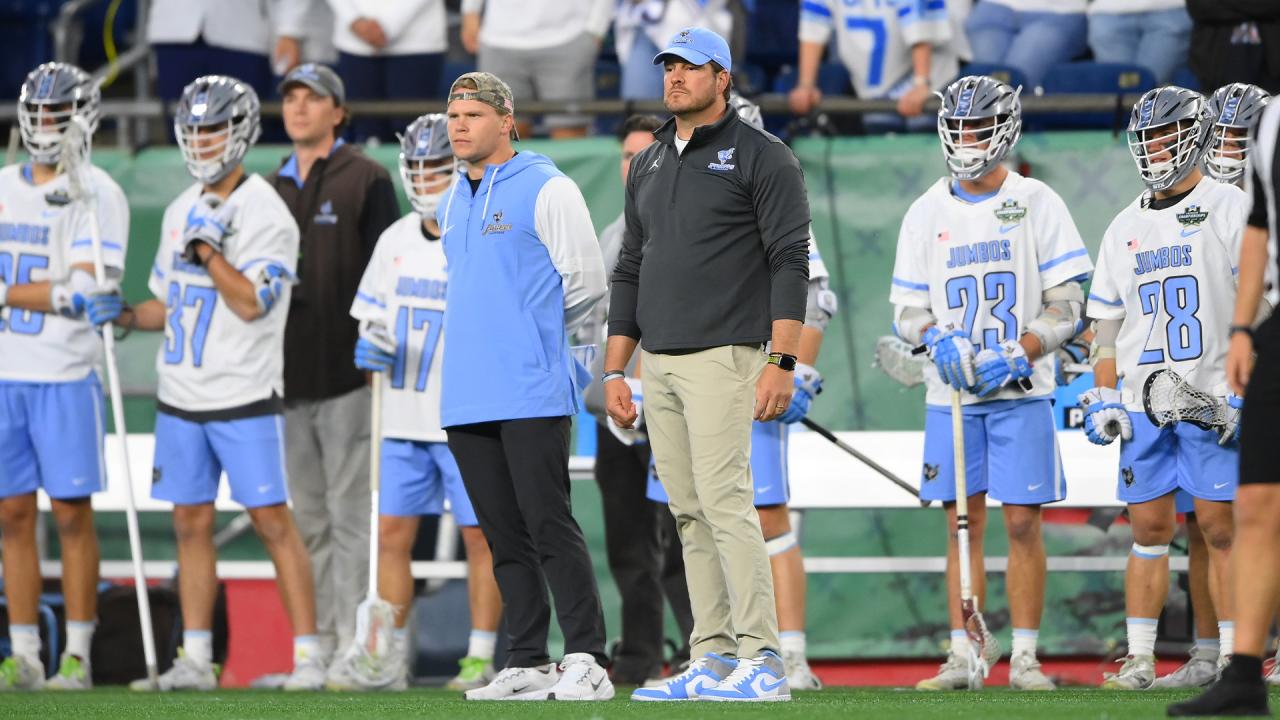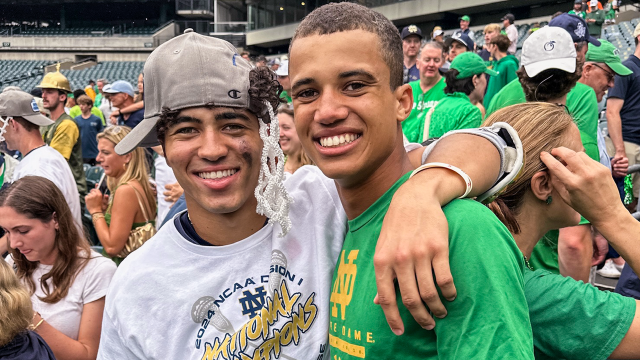
How Tufts Men's Lacrosse Went From Afterthought to Juggernaut
A WEEK REMOVED FROM WINNING a second consecutive national championship, Tufts men’s lacrosse head coach Casey D’Annolfo grabbed a shovel and started doing yard work in the backyard of his home in Andover, Mass.
He reminisced on the Jumbos’ historic 23-0 season, their 14-13 loss to Hamilton in the NESCAC quarterfinals in 2024 and losing the 2023 national championship to Salisbury — which has remained in the front of his mind.
Since taking over for the highly regarded Mike Daly in 2017, D’Annolfo has produced a 145-18 record. He’s led the Jumbos to six NESCAC titles, five consecutive championship weekend appearances and two national championships.
Some might consider Tufts a dynasty. D’Annolfo doesn’t. He thinks the Jumbos are still missing one key component.
“Consistent excellence,” D’Annolfo said. “We’re not there yet; we’re on our way. We’ve still got a lot of work to do.”
Apparently an undefeated season while playing the third-most difficult schedule in Division III, according to RPI, isn’t consistent enough. D’Annolfo added that to be considered a dynasty, you need to win three national championships in four years, which puts the Jumbos on the cusp.
It’s not that Tufts’ season wasn’t met with any turmoil or adversity. The Jumbos were met with controversy in September when 24 players were diagnosed and nine players were hospitalized with rhabdomyolysis, a rare muscle injury that releases muscle components into the bloodstream, according to the National Library of Medicine. The student-athletes were diagnosed with the life-threatening condition after the team participated in a voluntary workout on Sept. 16 led by an alumni who had completed Navy SEAL training.
After the final players were released from the hospital on Sept. 25, an external investigation commissioned by the university began. It was found that the SEAL, who declined an interview during the investigation, was deemed unqualified to lead the workout.

On the field, Tufts faced RIT and Chistopher Newport in just a five-day span from March 15-20. Both teams were ranked No. 3 in the nation when Tufts faced them. That was also RIT’s first opportunity to beat the Jumbos after losing 18-14 to Tufts in the previous national championship game.
It wasn’t close, as Tufts dominated in a 17-11 victory at the Mustang Classic. That was not the case in Newport News, Va., though. Tufts faced a talented but especially motivated CNU team as head coach Mikey Thompson’s father had passed away just a day before the game. The Jumbos were also without their leading scorer, attackman Jack Regnery.
Just five minutes into the contest, they faced a 6-0 deficit and trailed by as much as 10-3 by the 8:41 mark of the second quarter, but D’Annolfo and his players didn’t panic because they had been in that situation before.
In 2024, Tufts trailed Williams College 9-1 before roaring back to a 17-15 victory.
“Pretty much everybody that was on the team this year was on the team last year,” D’Annolfo said. “[I] said, ‘Hey, we’ve been here before. We know what we’re doing, just stay the course, pick up the next ground ball and we’re going to be good.’”
The Jumbos mounted a 7-0 run from the 5:45 mark of the third quarter to the 5:23 mark of the fourth quarter to grab a 16-14 lead, but two late goals from CNU forced overtime. What followed was arguably the most dramatic sequence in men’s lacrosse last year. Captains attackman Brett Jackson rung a stepdown shot off the post that bounced directly to the earth.
The home crowd roared in jubilation as a few CNU players raised their arms signaling a good goal, but Tufts goalie Conner Garzone had already heaved a pass to long-stick midfielder Ben Frisoli. His pass set up attackman Max Ettinghausen, who buried his only goal of the night.
Thompson challenged the CNU shot, but it was ruled a no goal, and the Jumbos won an exhilarating, emotional 17-16 game. The 10-3 deficit Tufts faced was the turning point of the Jumbos’ season.
“Obviously, that was not our best start to the game, but I think it was good for us because it showed us, ‘Hey, we’re not bulletproof,” Regnery said. “Coming off of a national championship in ‘24 and returning a lot of the players that we did, everyone felt really confident. Seeing those guys go out there and give us the business in that first half … I think it instilled a sense of urgency in us going forward.”
Tufts won its next four games by a combined score of 59-27 before having to eke out another overtime victory over No. 10 Wesleyan on April 5. To close the regular season, Tufts faced No. 6 Bowdoin in a double-overtime thriller. The Jumbos scored four consecutive goals to win 15-14.
D’Annolfo thinks that the close games were actually an advantage for them as they practiced high-intensity late-game situations all season.
“I think our guys just felt comfortable in close games,” he said. “The year before we played a bunch of close games, [the] past year we played a bunch of close games. I think for a lot of teams, when you get into close games, you kind of get tight, and our guys just have the utmost confidence.”
During championship weekend, Tufts met Bowdoin again and roared to a commanding 26-11 victory. A week later, the Jumbos cruised to a 25-8 win in the national championship game over Dickinson.
Like his coach who keeps the 2023 national championship game loss consistently on his mind, Regnery said he recognized how “fragile” those games are and didn’t want them to go to waste.
“We’ve been undefeated and lost, and we’ve lost in the conference tournament and won [the national championship],” D’Annolfo said. “There’s no perfect way to do this, so I think for us, we’re really just trying to build out our schedule and play the toughest teams possible in the toughest environments possible.”

When he moved on and I got the job, I was just trying to continue as many of those teachings and legacies that he and the guys before me built.
Casey D'Annolfo on former Tufts head coach Mike Daly
THE TURNAROUND
The top priority at Tufts wasn’t always winning national championships. The program was in arguably its darkest time when 26-year-old Mike Daly took over in 1999. They had a combined record of 3-25 in 1997-98 and successful NESCAC programs like Amherst and Middlebury found a way to drop Tufts from their schedules in 1999 because of how uncompetitive it was.
Daly said he was grateful the university allowed him to take baby steps when rebuilding the program. Tufts won its first NESCAC game under Daly when it beat Trinity 10-7 during his first season. That win broke a 19-game conference losing streak.
He built his program with three pillars in mind: fundamentals, discipline and excitement. The Jumbos qualified for the NCAA tournament in 2007 and made a momentous leap in 2010 after winning the NESCAC championship.
“We skipped a few steps there,” Daly said, “but it had been a pretty methodical march up until that point.”
After losing to Western New England in the first round of the NCAA tournament, Daly sent all his players a DVD of Cortland beating Gettysburg in the 2009 national championship game. Tufts alumni and current Dartmouth head coach Sean Kirwan said that helped them visualize reaching that same peak.
The next year, the Jumbos completed a 20-1 season after beating Salisbury 9-6 in the national championship game, and the program’s bar officially rose. Tufts’ only loss was to Connecticut College.
“I can still tell you more about that loss … and the goals we didn’t score and the goals that were scored against us than probably the national championship game,” Daly said. “That’s kind of the disease of the profession in some ways.”
Kirwan said that even though that squad wasn’t as polished as current-day Tufts teams, the Jumbos’ performance that year birthed the free-flowing style they play with now.
Daly finished his career at Tufts with three national championships (2010, 2014, 2015) a 247-83 record and seven consecutive NESCAC titles. Not only do Tufts fans have Daly to thank for the program’s turnaround, but also for recruiting D’Annolfo to Tufts before 2002.
He graduated from Tufts in 2006 as the only player in school history to score a lacrosse goal, throw a touchdown and score a field goal in basketball.
Daly, who was also D'Annolfo’s quarterback coach, said he knew there was a special motor to him when his lower teeth busted through his lip against Wesleyan after taking a hit to the face.
D’Annolfo got stitched up and proceeded to finish the game.
“He’s the type of guy who I really leaned on in my professional coaching career in terms of getting advice from him and working camps for him,” D’Annolfo said. “When he moved on and I got the job, I was just trying to continue as many of those teachings and legacies that he and the guys before me built.”

ONE “BIG HEAT CHECK”
After Kirwan graduated in 2012, Daly brought him back as a graduate assistant, and the Jumbos offense rose to new heights. Under Kirwan in 2014, Tufts scored 423 goals and set an NCAA record across all divisions at the time.
That team had a four-headed monster with Cole Bailey, Chris Schoenhut, Beau Wood and midfielder John Uppgren that combined for 283 goals.
Kirwan said they recruited so many high-level attackmen to that team that Tufts put a copious amount of them at defensive midfield. One of those former high school attackmen was Conor Helfrich, who transitioned to being a faceoff specialist.
Helfrich recorded seven points that season, including a goal in the national championship game, on top of shooting the ball 44 times.
“We had all-state high school attackmen, players of the year for their high schools, attackmen coming into the office asking to play defensive midfield,” Kirwan said. “So, it created this monster of transition offense and abilities to really attack at all phases.”
Kirwan credited his offensive style as a blend of the creativity Daly allowed him to play with and the methodical structure he learned as a high schooler under Mountain Lakes (N.J.) head coach Tim Flynn. The latter is second all-time in high school wins behind former West Genesee (N.Y.) head coach Mike Messere.
“For me to take the things that I loved about both and the things I believed in about both was such a fun project while I was coaching there,” Kirwan said. “It’s really the things that I’ve kept every step of the way in my coaching career.”
Kirwan brought his offense to Brown in 2015 under Lars Tiffany, and it took one season for that same system to light up the Division I ranks. Brown’s offense led the NCAA with 310 goals in 2016, which ranks third all-time behind Penn State in 2019 and UAlbany in 2015.
Kirwan wasn’t nervous about adopting the offense he ran at Tufts to Brown or then to Virginia, where he won two national championships (2019 and 2021), calling himself “delusionally optimistic.”
While the eccentricities of Tufts’ style and tempo can draw a lot of valid attention from lacrosse junkies, Kirwan said that Tufts has always been about letting its players play to their strengths.
“That’s what coach Daly allowed myself to do with all my teammates,” Kirwan said. “He never put us in a box, he never forced us to play a certain style. So, it creates a very unique and ever-growing and changing type of system. It's our job as coaches to put our guys in the best positions to succeed, so that can change year-to-year.”
The schematic details about how the Jumbos’ offense operated with Bailey, Jack Boyden or now Jack Regnery as the quarterback can change, but Kirwan said the mindset hasn’t.
After Kirwan left in 2015, Tufts' offense continued to smash records. The Jumbos broke Wesleyan’s record of 438 goals in 2022 and then broke their own record the next season when they amassed 468 goals. That record stands as the most goals scored in a season across all divisions.
“Casey has done the same thing that coach Daly did,” Kirwan said. “He’s just a player’s coach that makes sure his guys are in the best chance to succeed and play to their strengths, which is a mark of a really smart and great coach in a lot of ways.”
D’Annolfo said that 80 percent of Tufts’ practices work as a “big heat check.” He encourages his players to try different and unique things so they know exactly what works and what doesn't work by the time May comes around.
“They’re incredibly bought into what we’re teaching them,” D’Annolfo said. “They know the effort that they played with in the regular season is not going to be good enough for the playoffs.”
He said that he had a few people visit when they practiced the day before the national championship game, and they were taken aback by the intensity the Jumbos showed.
“Every practice is going to be intense,” D’Annolfo said. “So you have that kind of consistency in your messaging, in terms of what you’re doing at practice every single day, it’s pretty easy to get the guys to understand what they’re getting into.”
D’Annolfo described his style as the, “Best parts of lacrosse.” He compared it to the no-huddle offense that 2010 AP Football Coach of the Year Chip Kelly ran at Oregon. Regnery, who shot over 20 times during two games last season, compared Tufts’ offense to the Showtime Los Angeles Lakers.
Whether Regnery is Marcus Mariota or Magic Johnson, his aggressive play style embodies how D’Annolfo wants them to play. The Jumbos finished the season first in the nation with 418 goals, while averaging 58.5 shots each game. According to Lacrosse Reference, Tufts ran the seventh-fastest pace in D-III last season — an aggressive feat for a team that was leading games throughout the vast majority of the season.
However D’Annolfo instills that swagger and confidence into his players, whether it be through his attitude at practice or gameday Jordans, his style — and the schemes passed down over the years — have Tufts on the brink of a dynasty.
Hayden Hundley
Hayden Hundley has been involved with lacrosse since he was 6 years old and was brought on as Editorial Intern at USA Lacrosse in May 2025. He has covered Virginia men’s lacrosse with Streaking the Lawn, scouted DMV talent with Prep Lacrosse and was formerly the Sports Editor for James Madison’s student newspaper "The Breeze."

Related Articles





